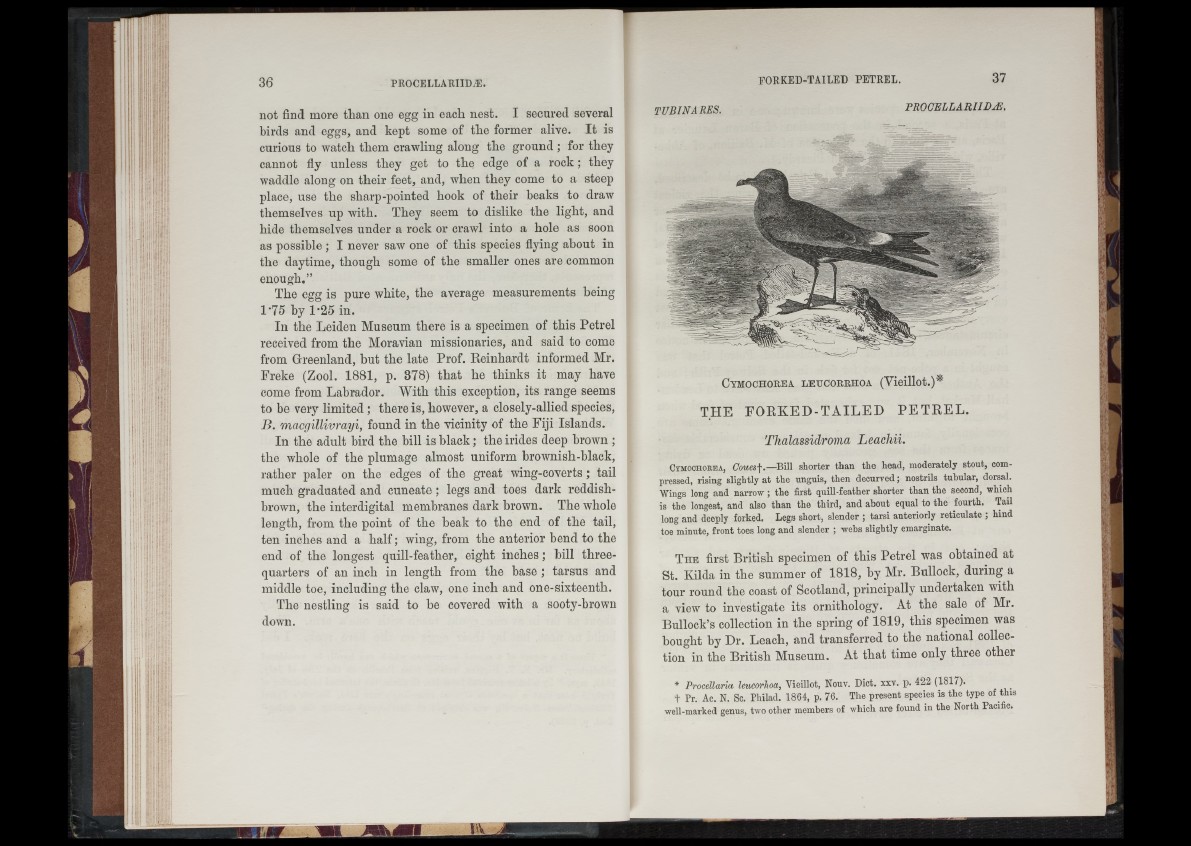
not find more than one egg in each nest. I secured several
birds and eggs, and kept some of the former alive. It is
curious to watch them crawling along the ground; for they
cannot fly unless they get to the edge of a rock; they
waddle along on their feet, and, when they come to a steep
place, use the sharp-pointed hook of their beaks to draw
themselves up with. They seem to dislike the light, and
hide themselves under a rock or crawl into a hole as soon
as possible ; I never saw one of this species flying about in
the daytime, though some of the smaller ones are common
enough.”
The egg is pure white, the average measurements being
1-75 by 1-25 in.
In the Leiden Museum there is a specimen of this Petrel
received from the Moravian missionaries, and said to come
from Greenland, hut the late Prof. Reinhardt informed Mr.
Freke (Zool. 1881, p. 878) that he thinks it may have
come from Labrador. With this exception, its range seems
to be very limited; there is, however, a closely-allied species,
B. macgillivrayi, found in the vicinity of the Fiji Islands.
In the adult bird the bill is black; the irides deep brown ;
the whole of the plumage almost uniform brownish-black,
rather paler on the edges of the great wing-coverts ; tail
much graduated and cuneate ; legs and toes dark reddish-
brown, the inter digital membranes dark brown. The whole
length, from the point of the beak to the end of the tail,
ten inches and a half; wing, from the anterior bend to the
end of the longest quill-feather, eight inches; bill three-
quarters of an inch in length from the base ; tarsus and
middle toe, including the claw, one inch and one-sixteenth.
The nestling is said to be covered with a sooty-brown
down.
TUBINARES. PROCELLARIIDÆ.
Cymochorea l eu co r rh o a (Vieillot.)*
THE FORKED-TAILED P E T R E L .
Thalassidroma Leacliii.
Cymochorea, Cones f .—Bill shorter than the head, moderately stout, compressed,
rising slightly at the unguis, then decurved; nostrils tubular, dorsal.
Wings long and narrow; the first quill-feather shorter than the second, which
is the longest, and also than the third, and about equal to the fourth. Tail
long and deeply forked. Legs short, slender ; tarsi anteriorly reticulate ; hind
toe minute, front toes long and slender ; webs slightly emarginate.
T h e first British specimen of this Petrel was obtained at
St. Kilda in the summer of 1818, by Mr. Bullock, during a
tour round the coast of Scotland, principally undertaken with
a view to investigate its ornithology. At the sale of Mr.
Bullock’s collection in the spring of 1819, this specimen was
bought by Dr. Leach, and transferred to the national collection
in the British Museum. At that time only three other
* Procellaria leucorhoa, Vieillot, Nouv. Diet. xxv. p. 422 (1817).
t Pr. Ac. N. Sc. Philad. 1864, p. 76. The present species is the type of this
well-marked genus, two other members of which are found in the North Pacific.